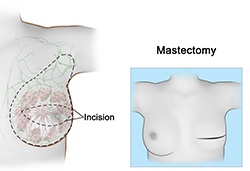Mastectomy

Mastectomy is a surgery to remove the breast, usually performed to treat or prevent breast cancer. There are different types of mastectomy depending on the stage of cancer, size of the breast tumour and lymph node involvement:
- Total mastectomy: In this procedure, all the breast tissue, including nipple are removed
- Nipple and Skin Sparing Mastectomy: This technique can be used in combination with the above surgeries to retain your natural skin and nipple. This can only be done in some cases.
- Partial mastectomy
Indication
Mastectomy is recommended when your breast is affected with cancer or you have a high risk of developing breast cancer.
Procedure
. The procedure is performed under general anaesthesia. A/Prof Fosh will make an oval shaped incision around the nipple, across the breadth of the breast. Depending on the type of mastectomy, the breast tissue underlying the skin will be removed, along with lymph nodes if there is invasive cancer. A surgical drain (tubes to collect excess fluid) is usually inserted and the incision closed.
Post-op care
This surgery will require you to stay in the hospital overnight. To avoid stiffness and scar formation, you must follow some simple hand exercise regimes.
Risks and complications
Mastectomy procedures are usually safe, but may involve the risk of infection, bleeding, pain, swelling in your arm, hard scar tissue formation at the site of surgery, shoulder pain and stiffness, numbness (especially under your arm), and accumulation of blood or fluid (seroma) in the surgical site.
